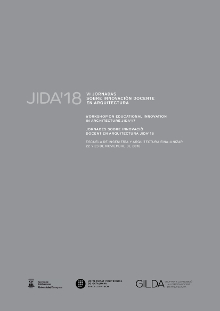La Didáctica del Territorio. Un Modelo para Armar
DOI:
https://doi.org/10.5821/jida.2018.5481Resumen
El artículo presenta una experiencia de metodologías activas aplicadas en la enseñanza y aprendizaje del taller de arquitectura, resultado de la investigación de Innovación Docente “La Didáctica del Territorio. Un modelo para Armar” , centrada en el aprendizaje situado y contextualizado, y en el legado de una tradición disciplinar en la enseñanza de la arquitectura en Chile, que trascendió por las escuelas de arquitectura del país, instalando la discusión en torno a los conceptos de “Acto” y “Observación”, arquitectónica.La propuesta, un proceso de sistematización de estrategias que los estudiantes deben armar en un modelo pensar-hacer situado, tiene como objetivos, desarrollar competencias y habilidades disciplinares emplazando al estudiante ante acciones donde se exhorta en la comprensión del territorio como una construcción social e histórica, que surge desde el Acto Arquitectónico, y orientando su accionar hacia el logro de un aprendizaje significativo, y de un conocimiento nuevo, transformador y socio crítico.
Citas
AGUIRRE, Max. (2007). Arquitectura en la Historia. La Historicidad de la Arquitectura. Revista ArteOficio Nº6. Escuela de Arquitectura. Universidad de Santiago de Chile. Consultado en Revistas y Publicaciones. Ediciones Electrónicas. http://www.revistas.usach.cl/ojs/index.php/arteoficio/article/view/860
BAIXAS, et al. (2005). Cuatro escuelas de arquitectura. Revista ARQ (Santiago) nº.61 La Profesión. Santiago dic. 2005. Consultado en agosto 2017, en http://dx.doi.org/10.4067/S0717-69962005006100004
CORNEJO, Marcela et al. (2008). La Investigación con Relatos de Vida: Pistas y Opciones del Diseño Metodológico. Revista PSYKHE 2008, Vol.17, No 1, 29-39. Pontificia Universidad Católica de Chile.
DE CERTEAU, Michel. (1996). La invención de lo cotidiano 1. El oficio de la Historia Ed. IBEROAMERICANA México.
FREIRE, Paulo. (1997). PedagogÃa de la AutonomÃa. Saberes necesarios para la práctica educativa. Siglo XXI Editores. México.
MUNTAÑOLA, J. (2009). Topo génesis. Fundamentos de una nueva arquitectura. Arquitectonics. Edicions UPC. Barcelona. 2009
POZO, J. (2010). TeorÃas cognitivas del aprendizaje. Facultad de PsicologÃa de la Universidad Autónoma de Madrid. Ediciones Morata, S. L. Décima edición. Madrid, España.
PRADO, A. (2012). Teatros del desierto. Producción del espacio ciclos económicos. Tesis Doctoral Inédita. Doctorado Departamento de Composición Arquitectónica de la Escuela Técnica Superior de Arquitectura de Barcelona (ETSAB) Universidad Politécnica de Catalunya (UPC). Barcelona. 2012.
SENNET, R. (1994). Carne y piedra. El cuerpo y la ciudad en la civilización occidental. Alianza Editorial. Madrid. 1994.
SOSA, Mario. (2012). ¿Cómo entender el territorio? Editorial Cara Parens Universidad Rafael LandÃvar. Guatemala.
SWARTZ, R., et al. (2013). El aprendizaje basado en el pensamiento. Cómo desarrollar en los alumnos las competencias del siglo XXI. Madrid: sm
TISHMAN, S. PERKINS, D. JAY, E. (1994). Un aula para pensar: Aprender y enseñar en una cultura de pensamiento. Buenos Aires: Aique.






















